Pristine white peaks all around, and skis crunching over crisp snow. If any holiday feels like escapism, it’s a ski holiday. But climate breakdown is increasingly threatening to poop the party.
The latest research, published in the journal Nature Climate Change, is stark. Climatologists analysed snow cover at 2,234 ski resorts, from Iceland to Turkey. “If there was 2C of global warming, about 27% of resorts would have scarce snow every other year,” says Samuel Morin, co-author and research scientist at Météo-France (the French meteorological service) and CNRS (France’s science agency). “At the more extreme case of 4C, this figure rises to 71% of resorts. The situation depends on the region and elevation, but snow conditions everywhere would be affected.”
What to do? Transport, ski lift infrastructure, accommodation, food and equipment all contribute to the eco-footprint of a skiing holiday. “The ski industry is waking up to the need for significant action,” says Dom Winter, head of programmes at the outdoor climate action charity Protect Our Winters (POW) UK. “The status quo is no longer an option.”
Many resorts are taking action on the ground. In the popular French resort of Morzine, for example, Montagne Verte is a nonprofit association of more than 35 local businesses taking sustainable action. It has opened a secondhand shop and created a food-waste-to-fuel collection service. And through its AlpinExpress scheme, holidaymakers coming by train get exclusive discounts from local businesses – including 10% off the cost of a ski pass.

Compagnie des Alpes, which manages the ski areas of many of France’s largest resorts, has converted its fleet of snow groomers from diesel to HVO100 synthetic fuel. This 100% renewable fuel, made from waste, fats and used vegetable oils (and without palm oil), emits 90 less CO2 and cuts less fine particle emissions by 65%. Also in France, the Flocon Vert sustainability label awards ski resorts for significant, ongoing improvement in environmental initiatives.
At Tenna, in Graubünden, Switzerland, a solar ski lift started operating in 2011 and produces more energy than is needed for its winter operations, while in Engelberg all mountain railways are powered entirely by hydroelectric energy. Eco measures in Austrian resorts include a solar lift in the Tirol’s SkiWelt Wilder Kaiser-Brixental area (opened in 2008), and various sustainability projects, with all lifts now running on 100% renewable electricity. The Silvretta Arena Ishgl-Samnaun region has also switched to 100% green electricity from renewable sources. It also co-finances ski buses to reduce car traffic and supports reforestation projects.

Using your voice is crucial. Winter says: “What’s vital is letting the decision-makers know your concerns. Choosing resorts and businesses that are progressive on sustainability helps support those doing the right thing. You bring about the strongest change by then telling the other resort or company why you didn’t use them.”
Clothing reuse initiatives have been springing up across winter destinations, too. EcoSki and WhoSki enable skiers to rent or buy secondhand gear. And since September 2022, repurposing collective Re-Action has prevented more than 35,000 items of outdoor clothing from going to landfill. “Patched garments are fast becoming a badge of honour,” says Gavin Fernie-Jones, founder of Re-Action and the Courchevel-based project One Tree at a Time, which advises the ski industry on sustainability.
In terms of the overall carbon emissions of ski holidays, mode of transport dwarfs other factors. This month, POW UK calculated that when a skier travels from the UK to the French Alps by plane, the total gas emissions are typically 395kg CO2e (ie, carbon dioxide equivalent), with 250kg CO2e resulting solely from the journey. By train the total holiday emissions shrink to 156kg CO2e, because the train journey creates only 11kg CO2e.
The challenge is that in recent years rail options for skiers have decreased. Eurostar has ditched its direct London to Bourg-Saint-Maurice ski train (capacity 750 skiers a train) for an indirect service, Eurostar Snow, with a change of train at Lille. Its capacity is 250 skiers and the service runs only to the start of February, halving the normal number of departures. For indirect routes via Paris, options are more limited too. In the winter 2019-20 season, Eurostar ran 14 departures from London to Paris on Saturdays. At the time of checking, only 10 were scheduled in January 2024.
Eurostar says it plans to expand the service in future, but that post-Brexit border requirements make operating the direct ski train increasingly complex. “In the long term, we are committed to increasing the options to our ski destinations,” a spokesperson said. “We are aware of the strong demand for sustainable travel.”
Ski tour operators are frustrated by the current state of affairs. One of the largest, Inghams, has ambitious plans to halve its carbon emissions by 2030. This winter, the company will offer rail-inclusive ski packages to 22 resorts across France, Austria, Italy and Switzerland.
“We’re determined to make it as easy as possible for customers to choose train instead of plane,” says Krissy Roe, senior sustainability manager. “There’s clearly an appetite for train travel, so we urgently need more direct and regular routes running throughout the season – and more competitively priced tickets. To get serious about switching planes for trains, we need a level playing field.”
Morin couldn’t agree more. “To really lower the carbon footprint of ski holidays, switching from car or plane to train is essential,” he says.
La Rosière, France

This accessibly priced, family-friendly resort is blessed with sunny, sweeping views of the Haute Tarentaise Valley and connected to the Italian ski village La Thuile. Together the two resorts bring downhillers 154km of pistes with something for all skill levels, plus freeride terrain. While dining here is typically cosy and authentic, there’s also the recent addition of Le Terroir des Vignobles, which is refined but well priced. Another hunger-busting highlight is the legendary “skier’s menu” at the Pepita Cafe in La Thuile. Ski-free activities include ice skating, outdoor paintballing, snowshoeing, the rail-mounted Xtreme Luge ride and snow golf. The resort offers a 15% discount off visitors’ next lift pass if they use the train to get there.
By train: 8¼ hours
The Eurostar Snow service leaves London St Pancras at 09.01 to Lille Europe; there you switch to the 12.15. Thalys train to Bourg St Maurice, arriving at 18.20. From there it’s 40 minutes by bus or taxi.
Stay
Mountain Heaven has a spacious catered chalet, The Penthouse, with double rooms from £799 per person per week, including all meals and unlimited wine.
Morzine, France

This handsome town is active all year round. It makes an excellent base for exploring the glories of the vast Portes du Soleil ski area, whose well-organised lift system and multiple entry points from the valley make it suitable for every level of skier or snowboarder. Once on the hill, there are 600km of pistes, 30 fun zones and seemingly endless off-piste terrain. Nor is there any rest for non-skiers: Morzine offers 42 non-ski activities including snowshoe hikes, snowmobiling and horse-drawn carriage rides.
The village has plenty of interesting restaurants and boutiques. Antony Dorland, who has worked as a chef in Michelin-starred restaurants, runs Solide cafe, working with small-scale local producers; the crockery is made by a local potter. A solid portfolio of eco efforts includes a white-tailed sea eagles reintegration programme in the Aigles du Léman wildlife park.
By train: 8⅓ hours
Depart London St Pancras on the 09.31 Eurostar to Paris Gare du Nord; change to Paris Gare de Lyon and take the 14.18 TGV to Bellegarde, then the 17.15 TER to Cluses, arriving at 18.52. From there it’s 40 minutes by bus or taxi.
Stay
Independent chalet company Alikats has the spacious Ferme à Jules chalet with superb catering from £645pp a week.
Saas-Fee, Switzerland
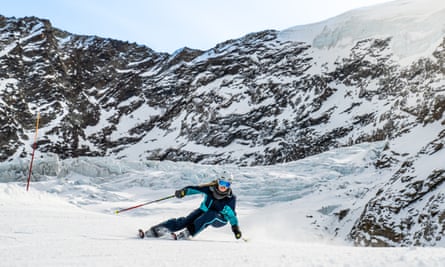
This car-free, high-altitude charmer in the canton of Valais is officially the world’s first carbon-neutral municipality. Run on hydropower, it’s a twinklingly traditional resort and was the setting for Wham!’s Last Christmas video. Today, the resort earns accolades for innovative eco initiatives such as zero-emission ski buses. Saas-Fee’s 150km of terrain is exceptionally snowsure and breath-stealingly beautiful, overlooked by about 18 peaks over 4,000 metres and two glaciers. For intermediates there are long red glacier runs. Even the resort’s gentlest runs are surrounded by scenic ruggedness.
The streets of this historic village are ravishing too. Rustic timber chalets rub rafters with all manner of eateries: elevated snack joints, authentic Alpine inns and world-class fine-dining restaurants. Back on the mountain, alpine canyoning, ice climbing, a zipline, illuminated night sledging and a winter via ferrata are among the many ways the resort strives to share its outstanding natural riches with non-skiers. It’s hard to imagine a more jaw-dropping Alpscape for your first tandem paragliding flight.
By train: 9¾ hours
Depart London St Pancras on the 09.31 Eurostar to Paris Gare du Nord; change to Paris Gare de Lyon and take the 14.10 TGV to Geneva, then the 18.10 InterRegional to Visp, arriving at 20.23. From there it’s 50 minutes by connecting bus.
Stay
Close to the ski lifts, the 17-room Hotel Ambiente prides itself on its friendly guest lounge and its creative restaurant menu. Doubles from 95 CHF (about £85).
Les Arcs, France

The vastly popular, multi-village resort of Les Arcs has announced that it will stop building, a radical move in a market where large resorts routinely continue adding luxury lodgings. This comes on top of sustainability measures that include upgrading its unique funicular railway, solar panels on lift stations and a drive to eliminate single-use plastics. There are plenty of other ways Les Arcs is exceptional. Skiers have access to a whopping 425km of pistes of the Paradiski area (including neighbouring Peisey-Vallandry and La Plagne). These reach 3,250m and cater generously to every skill level.
This season, families can explore the feature-packed, on-slope kids’ adventure park, Giants of Malgovert. Guided tours tell the story of the egalitarian, 1960s architecture of Charlotte Perriand, Corbusier protege and designer of Arc 1600. Party people will enjoy après-bar La Folie Douce, which promises an augmented programme of open-air shows with DJs, vocal performers, dancers, acrobats and musicians.
By train: 8¼ hours
The new Eurostar Snow service departs London St Pancras at 09.01 to Lille Europe; there you switch to the 12.15. Eurostar continental (Thalys) train to Bourg St Maurice, arriving at 18.20. From there it’s seven minutes by funicular to Arc 1600, with connecting buses to the other villages (15–30 mins).
Stay
Inghams offers a seven-night package including travel by Eurostar Snow and a stay at Hotel Les Mélèzes, for £839pp half board.
St Anton am Arlberg, Austria
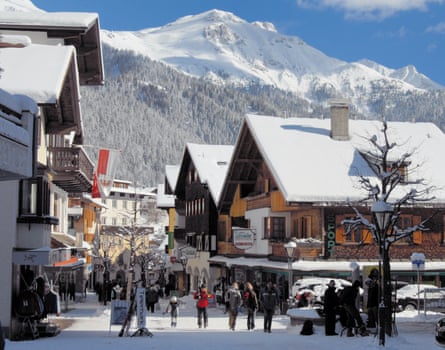
Accessible by rail since 1884, this former farming village boasts impressive eco credentials, including being fully self-powered by locally produced hydroelectricity since 2006. Now linked within Austria’s largest ski area, Ski Arlberg, this Tirolean titan offers 300km of pistes as well as 200km of freeride routes. Non-skiers can sample downhill thrills at scale too, notably on the 4.3km Gampen toboggan run.
Alongside impressive and diverse culinary credentials, and a buzzing après-ski scene, St Anton has a substantial wellness offering. Pool and spa facilities include the large, sleek WellCom centre, and arl.park offers indoor climbing, bouldering, tennis and bowling, and there are yoga classes in several village studios. Back outdoors, activities for non-skiers include 80km of winter hiking trails, husky sledding, snowshoeing, a via ferrata, ice skating and curling.
after newsletter promotion
By train: 10½ hours
Depart London St Pancras on the 07.31 Eurostar to Paris Gare du Nord; take the 12.22 TGV from Paris Gare de Lyon to Zurich, and from there the 16.40 Railjet, arriving at St Anton at 19.01.
Stay
Himmlhof, a cosy boutique hotel retaining its 17th-century farmhouse charm, has doubles from €155 B&B.
Saint-Martin-de-Belleville, France
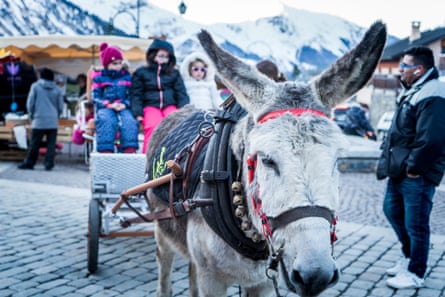
Saint-Martin-de-Belleville offers a uniquely genteel way to holiday in France’s mighty, 600km Trois Vallées, the world’s biggest ski area. With its 16th-century church tower, this traditional village offers a blend of low-key luxury and old-world charm. The resort is taking measures to preserve wildlife in the ski area, setting up a beehive in an old chalet and creating biodiversity corridors.
The village has some handsome chalets and a few swish hotels, and retains a relaxed ambience.
Foodies will be in their element here, and the father and son who put the village on the gourmet map with the three-Michelin-starred La Bouitte restaurant now offer more affordable fare in their newish Simple & Meilleur bistro. Cosy après entertainment can be found in the cute Pourquoi Pas bar, while classical and jazz concerts are held at the church.
By train: 7½ hours
The Eurostar snow service departs London St Pancras at 09.01 to Lille Europe; from there the 12.15 Eurostar continental (Thalys) train runs to Moûtiers, arriving at 17.30. From here it’s 25 minutes by bus or taxi.
Stay
Seven nights’ self-catering in a two-bedroom apartment in Les Chalets du Gypse in Saint-Martin-de-Belleville, with Peak Retreats costs from £571pp based on four sharing.
Kirchberg, Austria

Compared with neighbouring, Kitzbühel with its chic boutiques, Kirchberg is smaller and more down to earth. The two resorts share the slopes of the KitzSki, with a sizeable 170km of pistes, including the world-famous Hahnenkamm downhill. The slopes particularly suit intermediates, but beginnners will find this an excellent place to learn too. The 3.3km toboggan run on the Gaisberg in Kirchberg follows some captivating woodland terrain, and when the slopes close, this is no sleepy town. Flannigan’s Irish Pub is a good place to meet straight off the slopes. For a more local flavour, try Jederzeit, Vis-à-Vis and Almrauschbar, whose terrace has panoramic views over the Gaisberg.
By train: 17¼ hours
Take the 15.04 Eurostar to Brussels-Midi, arriving 18.05, then the 18.25 ICE to Cologne, arriving 20.15. Then take the 21.45 Nightjet sleeper train to Wörgl, arriving 08.37, and then the 08.59 InterCity, arriving 09.19. The railway station is in the village.
Stay
Hotel Zentral, 500 metres from the train station, has doubles from €130 B&B.
Montgenèvre, France
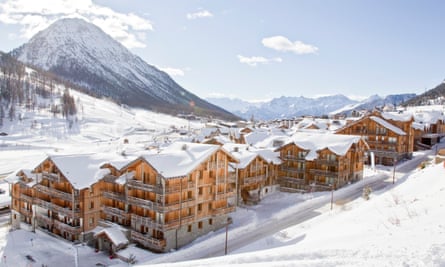
Families and first-timers in particular will thrive in Montgenèvre, an attractive unpretentious village on the Italian border. Gentle, tree-lined slopes fan out from the cafe-lined slopes.
Intermediates will be in their element, too: the resort is part of the 400km Milky Way ski area. The vast Durancia pool and spa complex offers water-based fun and relaxation. Dog sled rides, ice skating and paragliding are some of the many other activities that will keep non-skiers entertained. The restaurants here have plenty of Italian influence, such as wood-fired pizzas conjured up at Le Capitaine.
By train: 8¾ hours
Depart London St Pancras on the 15.31 Eurostar to Paris Gare du Nord; change to Paris Gare d’Austerlitz and take the 20.50 Intercités de Nuit to Briancon, arriving at 08.22. From there it’s 40 minutes by bus or taxi.
Stay
The attractively designed, piste-side Hotel Anova has doubles from €173 B&B, and a spa, too.
Bad Gastein, Austria
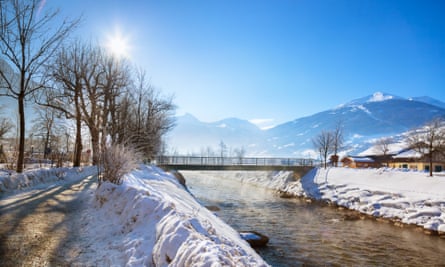
Water-powered wellness is the hallmark of a stay in the Gastein valley, whose springs and radon-emitting caves have been attracting health tourists for centuries. And the elegant, Belle Époque resort of Bad Gastein has elevated spa culture to a rarefied art, with cosy facilities in most hotels as well as huge public palaces of pampering such as the cathedral-esque Felsentherme. The resort is also a yoga mini-mecca year-round.
But first, a little skiing? The valley offers more than 200km of pistes, ranging from leisurely wide cruisers to easily accessed freeride terrain, as well as 40km of scenic cross-country ski tracks on the valley floor. Wellness bubbles up outdoors here too, with winter forest bathing a signature ski-free option, among a family-friendly roster that also includes tobogganing, snowshoe hiking, husky sledding and, for the more intrepid visitor, ice climbing.
By train: 17¼ hours
Take the 15.04 Eurostar to Paris Gare du Nord, arriving 18.05, then the 18.58 Nightjet sleeper train from Paris Gare de l’Est (almost next door) to Salzburg Hauptbahnhof, arriving 07.26, and then the 08.12 InterCity, arriving 09.41. The station is in the village centre.
Stay
The Cōmodo translates a mid-century vibe into a modern mountain escape, with doubles from €150 B&B.
Sauze d’Oulx, Italy

If you love carving your way along tree-lined slopes and hunting down mountain restaurants, the slopes of Sauze d’Oulx won’t disappoint. Hidden in wooded enclaves are rustic huts such as Ciaô Pais, which serves delicious homemade cakes.
The resort is part of the vast Milky Way ski area, with 400km of pistes shared with Sestriere, Sansicario and, farther afield, Claviere and Montgenèvre.
Beginners will enjoy the Sportinia area, with its gentle sweeping runs. The village has a cobbled centre and plentiful places to eat. A good place to begin is the sunlit terrace of the Assietta hotel.
A number of restaurants compete to serve the best pizza, among them La Griglia, in the arches of an old townhouse. The resort has long shaken off its 1980s reputation as a magnet for boozy package holidays; now the atmosphere is friendly and vibrant rather than wild.
By train: 8¾ hours
Depart London St Pancras on the 09.31 Eurostar to Paris Gare du Nord; change to Paris Gare de Lyon and take the 14.45 TGV to Oulx-Cesana-Clavière-Sestrières, arriving at 19.23. From there it’s 15 minutes by bus or taxi.
Stay
Hotel Stella Alpina is just 150 metres from the slopes, and has doubles from €164 B&B.
 Top Naija News: Nigerian News, Breaking News Nigeria and World News Top Naija News is a daily news publication in Nigeria, delivering the latest breaking news in Nigeria and around the world.
Top Naija News: Nigerian News, Breaking News Nigeria and World News Top Naija News is a daily news publication in Nigeria, delivering the latest breaking news in Nigeria and around the world.



